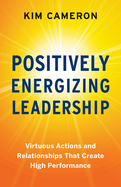Search Results: "servant leadership"
Results 67-72 of 522
Be BIG
2008
From diversity experts Judith Katz and Frederick Miller comes an illustrated guide to being your full-sized self in a very large workplace-world, Be BIG.
Too many people have decided that the safest way to get through life is to be small. They try not to attract attention to themselves, just tending their own safe little garden. They've decided it's too dangerous to think big, to speak out, to take risks. They might get shot down. Or look foolish. People will think they're just not good enough.
But, particularly today, organizations need people to step up and be BIG. We need new ideas, new products, new processes. People have to bring more of themselves to the workplace, to contribute more, and to have a bigger impact on the success of the organization.
This inspiring illustrated book challenges all of us to show up more fully as individuals and in our interactions with others and to find ways to be BIG together. In straightforward, incisive language, Judith Katz and Frederick Miller help us understand all of the many, sometimes subtle ways we make ourselves small. They show how we make others small as well and how these same attitudes can keep us from working together effectively. And they encourage us to nourish new attitudes that will make us, our coworkers, and our organizations bigger.
Be BIG invites us to bring more of ourselves to each situation—whether working independently, with another individual, or with a group—so that we can do our best work together.
Too many people have decided that the safest way to get through life is to be small. They try not to attract attention to themselves, just tending their own safe little garden. They've decided it's too dangerous to think big, to speak out, to take risks. They might get shot down. Or look foolish. People will think they're just not good enough.
But, particularly today, organizations need people to step up and be BIG. We need new ideas, new products, new processes. People have to bring more of themselves to the workplace, to contribute more, and to have a bigger impact on the success of the organization.
This inspiring illustrated book challenges all of us to show up more fully as individuals and in our interactions with others and to find ways to be BIG together. In straightforward, incisive language, Judith Katz and Frederick Miller help us understand all of the many, sometimes subtle ways we make ourselves small. They show how we make others small as well and how these same attitudes can keep us from working together effectively. And they encourage us to nourish new attitudes that will make us, our coworkers, and our organizations bigger.
Be BIG invites us to bring more of ourselves to each situation—whether working independently, with another individual, or with a group—so that we can do our best work together.
This practical guide, the first to show how leaders can achieve extraordinary results through the positive energy generated by virtuous interactions with employees, is written by one of the giants in the study of positive leadership.
This book reveals one of the most important but frequently ignored factors that lead to spectacular performance in organizations. Kim Cameron, a true pioneer in the study of positive leadership, offers validated scientific evidence that all individuals are inherently attracted to and flourish in the presence of positive energy, a principle known in biology as heliotropism. Further, he shows that the positive relational energy generated by leaders' virtuous behaviors—such as generosity, compassion, gratitude, trustworthiness, forgiveness, and kindness—is tightly linked to extraordinary organizational outcomes like greater innovation, higher profits, and increased engagement and retention.
Cameron has not written a feel-good tome about the power of positive thinking, “happiology,” or unbridled optimism. This research-based explanation shows how to achieve performance that exceeds expectations. He provides practical suggestions, assessments, and exercises showing how leaders can improve their own positive energy and increase positive relational energy in their organizations. Positively Energizing Leadership is a major contribution to the theory and practice of leadership.
This book reveals one of the most important but frequently ignored factors that lead to spectacular performance in organizations. Kim Cameron, a true pioneer in the study of positive leadership, offers validated scientific evidence that all individuals are inherently attracted to and flourish in the presence of positive energy, a principle known in biology as heliotropism. Further, he shows that the positive relational energy generated by leaders' virtuous behaviors—such as generosity, compassion, gratitude, trustworthiness, forgiveness, and kindness—is tightly linked to extraordinary organizational outcomes like greater innovation, higher profits, and increased engagement and retention.
Cameron has not written a feel-good tome about the power of positive thinking, “happiology,” or unbridled optimism. This research-based explanation shows how to achieve performance that exceeds expectations. He provides practical suggestions, assessments, and exercises showing how leaders can improve their own positive energy and increase positive relational energy in their organizations. Positively Energizing Leadership is a major contribution to the theory and practice of leadership.
The authors of the classic bestseller The Leadership Challenge bring their expertise to higher education, offering five practices that can make any college or university leader into an exemplary leader.
Drawing on the same pioneering research that formed the foundation of their classic bestseller The Leadership Challenge (over 2.7 million copies sold), James Kouzes and Barry Posner offer a set of leadership skills and practices that will make a significant difference in every area of higher education—faculty, administration, library services, career counseling, auxiliary services, campus safety, and more. It's about the behaviors that leaders, regardless of their position, use to transform values into actions, visions into realities, obstacles into innovations, segments into solidarity, and risks into rewards.
Kouzes and Posner tell the leadership story from the inside and move outward, describing it first as a personal journey and then as mobilizing others to want to do things they have never done before. The Five Practices of Exemplary Leadership is the operating system for this adventure. Leadership in Higher Education explains the fundamental principles that support these practices and provides case examples of people in higher education who demonstrate each one.
A core theme that weaves its way through all the chapters is that, whether it's one to one or one to many, leadership is a relationship between those who aspire to lead and those who choose to follow. We need leaders who can unite us and ignite us. This book lights the way.
Drawing on the same pioneering research that formed the foundation of their classic bestseller The Leadership Challenge (over 2.7 million copies sold), James Kouzes and Barry Posner offer a set of leadership skills and practices that will make a significant difference in every area of higher education—faculty, administration, library services, career counseling, auxiliary services, campus safety, and more. It's about the behaviors that leaders, regardless of their position, use to transform values into actions, visions into realities, obstacles into innovations, segments into solidarity, and risks into rewards.
Kouzes and Posner tell the leadership story from the inside and move outward, describing it first as a personal journey and then as mobilizing others to want to do things they have never done before. The Five Practices of Exemplary Leadership is the operating system for this adventure. Leadership in Higher Education explains the fundamental principles that support these practices and provides case examples of people in higher education who demonstrate each one.
A core theme that weaves its way through all the chapters is that, whether it's one to one or one to many, leadership is a relationship between those who aspire to lead and those who choose to follow. We need leaders who can unite us and ignite us. This book lights the way.
Fear Your Strengths
2013
Takes on the "play to your strengths" fad to show how your strengths can actually betray you
Features tools for keeping your strengths in balance as well as numerous examples of executives from varied backgrounds and companies
Published in collaboration with the Center for Creative Leadership, a top-ranked, global provider of executive and leadership education
Once you've discovered your strengths, you need to discover something else: your strengths can work against you. You can have too much of a good thing.
Thany leaders know this on some intuitive level, and they see it in others. But they don't see it as clearly in themselves. Mainly, they think of leadership development as working on their weaknesses. No wonder. The tools used to assess managers are not equipped to pick up on overplayed strengths. Nowhere in most assessments is there language or diagnostics that can reveal when someone is overdoing it-when more is not better.
This book takes on the "play to your strengths" fad to show how your strengths can actually betray you.
Once you’ve discovered your strengths, you need to discover something else: your strengths can work against you. Many leaders know this on some intuitive level, and they see it in others. But they don’t see it as clearly in themselves. Mainly, they think of leadership development as working on their weaknesses. No wonder. The tools used to assess managers are not equipped to pick up on overplayed strengths—when more is not better. Nationally recognized leadership experts Bob Kaplan and Rob Kaiser have conducted thousands of assessments of senior executives designed to determine when their strengths serve them well—versus betray them. In this groundbreaking book, they draw on their data and practical experience to identify four fundamental leadership qualities, each positive in and of itself but each of which, if overemphasized, can seriously compromise your effectiveness. Most leaders, they’ve found, are “lopsided”—they favor certain qualities to the exclusion of others without realizing it. The trick is to keep all four in balance. Fear Your Strengths provides tools to help you become aware of your leadership leanings and excesses and provides insights for combatting the mindset that encourages them. It offers a practical psychology of leadership, a better way for leaders to calibrate their performance so that you can make sure your strengths don’t overpower you but rather move you—and your organization—forward.
Great Leaders Grow
2012
The authors of the bestseller The Secret (over 350,000 copies sold)—legendary bestselling author Ken Blanchard and top Chick-fil-A executive Mark Miller—offer profound wisdom and practical advice for how to keep growing in your leadership effectiveness throughout your life.Successful leaders don’t rest on their laurels because leadership is not a title on a business card. Leadership is a living process—and life means growth. As Ken Blanchard and Mark Miller write in the introduction, “the path to increased influence, impact, and leadership effectiveness is paved with personal growth.… Our capacity to grow determines our capacity to lead. It’s really that simple.” Great Leaders Grow shows leaders and aspiring leaders precisely which areas to focus on so they can remain effective throughout their lives.
Debbie Brewster—the protagonist from Blanchard and Miller’s international bestseller The Secret—returns in this book to mentor her mentor’s son, Blake, as he begins his career. Now an accomplished leader herself, Debbie shows Blake how growing as a leader and as a human being are inextricably linked. “How well you and I serve will be determined by the decision to grow or not,” she says. “Will you be a leader who is always ready to face the next challenge? Or will you be a leader who tries to apply yesterday’s solutions to today’s problems?”
As Blake confronts the challenges of business in the real world, he turns to Debbie for guidance. Step by step, Debbie and Blake explore the GROW model—four ways that leaders must challenge and stretch themselves, both on the job and off, to fulfill their highest potential.
Whether you’re a CEO or an entry-level employee, this book will inspire you to reflect on your life and design your own long-term growth plan—a plan that can lead not only to continuing professional success but to personal fulfillment as well.























